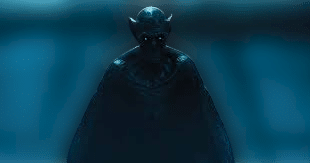Introduction:

In the annals of horror literature, few stories have left an indelible mark quite like Bram Stoker’s “Dracula.” This timeless tale of the undead has captivated readers for generations, spawning countless adaptations and interpretations. Among the many chilling aspects of the story, one often overlooked but integral element is “The Last Voyage of the Demeter.” This lesser-known chapter serves as a haunting prelude to the iconic events that unfold in Stoker’s masterpiece. In this blog post, we delve into the eerie and mysterious voyage of the ship Demeter, a vessel that carried with it the seeds of a terrifying nightmare.
Setting Sail: The Demeter’s Ill-Fated Journey:
“The Last Voyage of the Demeter” is a short yet impactful segment of Bram Stoker’s “Dracula.” The Demeter is a ship that departs from Varna, a port on the Black Sea, en route to London. Its voyage becomes the stuff of nightmares as it serves as the vessel that unwittingly brings Count Dracula to England. The crew aboard the Demeter experiences a series of eerie and unsettling events that foreshadow the horrors to come. Strange occurrences, unexplained deaths, and an overwhelming sense of dread permeate the ship, painting a vivid picture of the malevolent force that has come aboard.
The Atmosphere of Fear:
Stoker’s masterful storytelling is on full display in this chilling segment. He meticulously crafts an atmosphere of fear and unease that grips the reader from the very first page. The sailors aboard the Demeter are portrayed as hardened men, yet even they are unable to escape the growing sense of dread that envelops the ship. As they encounter inexplicable phenomena and witness their comrades succumb to mysterious deaths, their fear becomes palpable, mirroring the reader’s own growing apprehension.
The Power of Imagination:
Stoker’s genius lies in his ability to leverage the power of imagination. He employs vivid descriptions and unsettling imagery to stimulate the reader’s senses, allowing them to feel the same terror as the characters. The creaking of the ship, the relentless pounding of waves, and the eerie silence of the night contribute to the tension that builds throughout the narrative. Stoker understands that what is left unsaid can be just as terrifying as what is explicitly described, and he uses this technique to great effect in “The Last Voyage of the Demeter.”
Symbolism and Foreshadowing:
The Demeter serves as more than just a vessel for transporting the vampire to England; it is a symbol of impending doom and a harbinger of the horrors to come. The ship’s name itself is derived from the myth of Demeter, the Greek goddess of the harvest and fertility. In Stoker’s narrative, however, the ship is far from a bringer of abundance; instead, it carries with it a malevolent force that threatens to consume all in its path. This symbolic use of the ship reinforces the themes of inevitability and the inescapable nature of Dracula’s influence.
FAQs
What does Bram Stoker’s “Dracula” passage “The Last Voyage of the Demeter” refer to?
“The Last Voyage of the Demeter” is a pivotal and eerie segment in Bram Stoker’s iconic novel “Dracula.” It recounts the ill-fated journey of the ship Demeter, which carries the ancient vampire Count Dracula from Varna to England. This section serves as a haunting prelude to the events that unfold in the rest of the novel and is a key element in establishing the atmosphere of dread and fear.
2. How does “The Last Voyage of the Demeter” contribute to the overall story of “Dracula”?
This segment is crucial in setting the tone for the rest of “Dracula.” The Demeter’s voyage is a chilling display of the supernatural, featuring unexplained deaths, eerie occurrences, and an overwhelming sense of foreboding. It foreshadows the terror that Dracula’s presence will bring to England, heightening the suspense and anticipation for the reader.
3. What makes “The Last Voyage of the Demeter” a haunting tale?
Bram Stoker’s masterful use of atmosphere and imagery creates an intense and unsettling experience for the reader. The creaking ship, the relentless sea, and the growing unease among the crew all contribute to the story’s haunting nature. Stoker’s ability to evoke fear through vivid descriptions and the power of suggestion leaves a lasting impact, making it a truly haunting tale.
4. How does Stoker use symbolism in this part of the novel?
The ship Demeter’s name holds symbolic significance. In Greek mythology, Demeter is the goddess of harvest and fertility. However, in the context of Stoker’s narrative, the ship becomes a vessel of doom, carrying with it a malevolent force that threatens to consume all in its path. This use of symbolism enhances the themes of inevitability and the impending horror brought by Dracula’s arrival.
5. Why is “The Last Voyage of the Demeter” often overlooked in discussions about “Dracula”?
While “The Last Voyage of the Demeter” is a relatively short section within the larger novel, its impact is profound. It sets the stage for the unfolding terror and contributes to the overall sense of unease that permeates the story. Despite its brevity, this segment is a crucial component of the narrative and serves as a captivating glimpse into the supernatural world of “Dracula.
Conclusion:
“The Last Voyage of the Demeter” is a brief yet haunting chapter within the larger tapestry of Bram Stoker’s “Dracula.” Its significance lies not only in its contribution to the narrative but also in its ability to evoke a sense of terror that lingers long after the final page is turned. Through vivid descriptions, masterful use of atmosphere, and careful symbolism, Stoker crafts a tale that showcases the power of the unknown and the chilling impact of imagination. As readers, we are left to ponder the events that transpired aboard the Demeter, forever haunted by the lingering specter of Count Dracula’s arrival on English shores.
